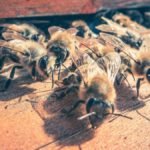I have been asked what time of day do bees swarm on many occasions. In this article we go into a few funny questions you may have about swarming. Do bees swarm at night? Why do they swarm? What time of year do bees swarm? You will see there are no real hard and fast answers, but there are a lot of fun facts.
Why Do Bees Swarm?
We have looked at how bees rear queens here, and how this can lead to swarming if we do not control it. In summary, it is a natural part of bee biology that bees will produce swarms. These bee swarms will leave the hive and find new places to build nests. If you are cunning you can lure such a swarm into a box and catch free bees.

What Time Of Day Do Bees Swarm?
This really depends on a number of factors. We need to think first about the logistics of swarming. A swarm consists of anywhere from 3000 bees to 70 000 bees if the entire hive absconds. That means that you have many pounds of bees which have to be warm enough to fly. They also need to be able to fly long distances without getting cold.
Temperature
Bees will swarm at a time of day when it is warm enough for them to fly. At temperatures below 55°F bees struggle to fly hence it is safe to say they will not swarm at this temperature unless they are trying to escape a fire or have had their hive wrecked by a bear. Typically bees would swarm at the maximum midday spring temperature one would expect in a temperate area. In tropical areas, they can swarm whenever they feel the urge.
If we use San Francisco as an example, bees were recorded to swarm in May and June in the 1980s, when peak day temperatures were above 62°F. I have personally seen bees migrate in Eucalyptus forests flowering in mid-winter when temperatures were below 60°F in various parts of the world.
In this regard, it is safe to say there are no really hard and fast rules to answer the question: what time of day do bees swarm? There is a broad trend that they will tend to swarm if temperatures are over 60°F and if they feel the need to swarm.
Day Length and Angle Of The Sun
In general, as the season moves from winter, to spring to summer the time of day the bees will swarm tends to get earlier and earlier as the days become longer and the angle of the Sun becomes more favorable to warming the bees. In my area bees swarm in early spring at 11 am. You can set your watch by it. By summer, bees are swarming at 9 am sharp. In fall, if they swarm, then it will be at 11 am again.
This will vary from location to location on Earth as the angle of the Sun and day length varies with your distance from the equator.
Do Bees Swarm At Night?
The short answer is no. Generally no. However, bees are a pain in the neck, and any generalization about what they do, and how they do it will be proven wrong occasionally. In emergencies, bees will swarm at night. If there is a fire, and there is a risk that their hive will be burnt, and there is a strong moon shining, the bees can fly from the hive and migrate short chaotic distances.
If they survive this emergency evacuation swarming incident, they will then regroup at sunrise and try to make a plan to ensure the continuity of their hive.
What Time Of Year Do Bees Swarm?
As discussed before, the increase in the number of bees in a hive, together with the age and pheromonal quality of a queen determines when bees build queen cells leading to swarming.
In an area where there are later honey flows, swarming will occur based on the availability of resources for swarming. In an area where there is a Mediterranean-type climate, many peak flowering events occur in winter. In these areas, you can even find that peak swarming will be in mid-winter.
A general rule is that bees swarm in spring as the days warm up and the flowers burst out. For much of North America, this rule is pretty accurate. However there are exceptions, and this is the lovely thing about bees. Bees are exceptional animals.
Emergency Swarms
A normal swarm occurs due to the hive increasing in population. An emergency swarm occurs when bees are forced to leave a hive due to it being burnt/flooded/destroyed. Sometimes a tree blows over in a storm and the bees have to leave their tree. Sometimes a building will be destroyed and the bees in a hidden place in the building have to make a plan. Sometimes bears ravish a few hives.
If a hive has to make an emergency evacuation the queen is normally in full egg-laying condition. She will be very heavy and will not be able to fly far. If the hive was not in a period of high egg-laying activity, the queen can normally fly 50 or so feet from the hive. This will normally be a downward sloping flight and she will land on the ground or in a bush.
An emergency swarm will stay for a day or two in the emergency site while they ready the queen to fly properly. Once this occurs they will then fly like any other swarm and move to a new area. When they land in the new area they will search for nesting sites, and attempt to establish a new hive.
As a beekeeper, the emergency swarm is much easier to capture and to re-hive. The bees are not in the mood to be flying anywhere. Give them a new hive with a frame of brood and a few combs of pollen. They will establish quickly and be thankful for the shelter.
We hope that this article has given you a few insights into how bad bees are at following rules, and how difficult they are to make generalizations about. Please share with friends.
Learn more about: How To Lure Bees Into A Hive

Dr. Garth A. Cambray is a Canadian/South African entrepreneur and beekeeper with 28 years of experience in apiculture and specializes in adding value to honey. His Ph.D. research developed a new advanced continuous fermentation method for making mead that has resulted in a number of companies globally being able to access markets for mead. His company, Makana Meadery, exports honey mead to the USA where it is available to discerning connoisseurs. He has also developed technologies to commercially manufacture organic honey vinegar in Zambia for export globally. He holds a few patents globally in the ethanol industry and believes in technology and knowledge transfer for human development and environmental sustainability. One of his proudest achievements is the fact that the wind farm he started at one of his old apiary sites has essentially made his hometown carbon neutral.






